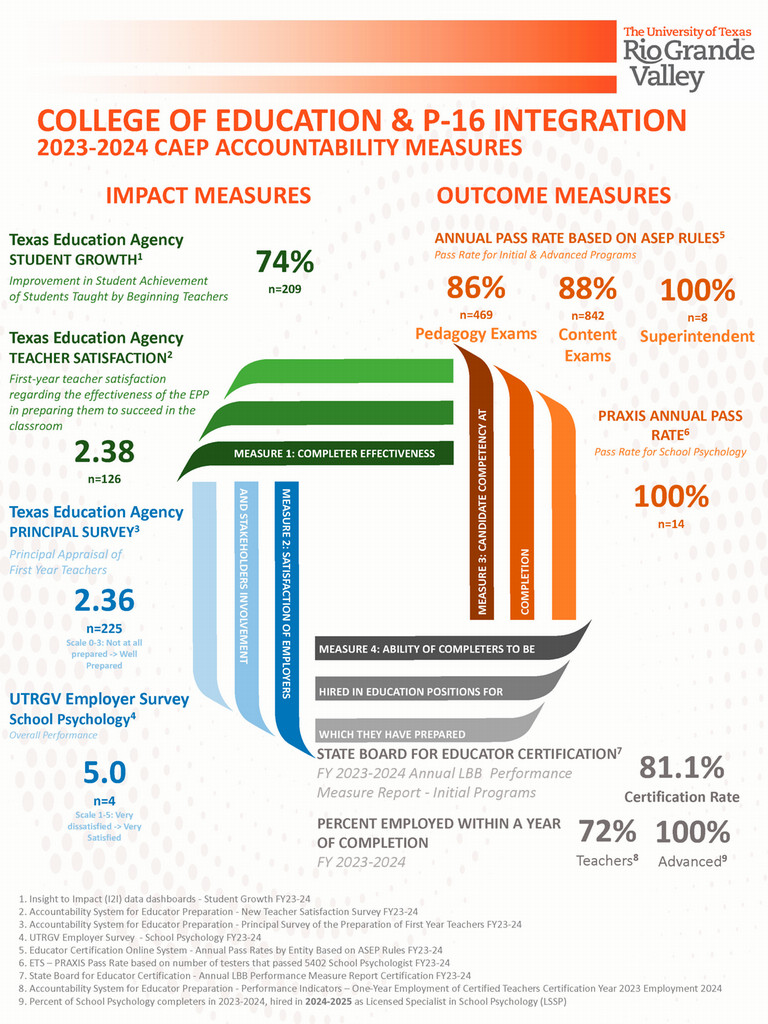UTRGV’s EPP has identified two strong indicators for Measure 1, Completer Effectiveness. The first data source is from the Texas Education Agency (TEA) Accountability System for Educator Preparation (ASEP) Improvement in Student Achievement of Students Taught by Beginning Teachers. The scoring approach uses multiple levels of aggregation to arrive at an evaluation of EPP performance. In the first level, TEA uses each student’s STAAR Annual Growth Points associated with each teacher to evaluate whether the teacher meets the SBEC standard. In the second level, the individual teacher performances (met or did not meet the standard) are then aggregated at the EPP level, and the EPP performance is determined by calculating the percentage of teachers who met the SBEC performance standard. Currently, STAAR results for grades 4–8, English II, and Algebra I end-of-course (EOC), are used. Available data from all students, including students with disabilities, are used in the calculation of this measure.
The EPP received student achievement data from the Texas Education Agency (TEA) for students taught by beginning, as shown on the ASEP manual. These student data from the STAAR progress measure were generated as part of the Accountability Rating System of districts, campuses, and charter schools and aggregates it to the EPP by linking the students to the beginning teachers who have completed the EPP. The information is calculated over a 3-year period. The data shows that 74% (n=209) of students taught by the EPP’s completers met the performance.
A second data source is the TEA Teacher Satisfaction Survey. New teachers under a standard certificate must respond to a survey at the end of the first year of teaching regarding the effectiveness of educator programs (EPPs) in preparing them to succeed in the classroom. The information gathered assists in improving the educational experience for teacher candidates through EPPs. The survey applies only to new teachers that completed an EPP in Texas. Current State Board for Educator Certification (SBEC) rules in 19 Texas Administrative Code (TAC) §229.3(f)(5), require each new teacher in a Texas public school to complete a survey about the effectiveness of their preparation.
In 2023-2024, 126 new teachers prepared by the EPP responded to this survey. Results indicated an overall mean score of 2.38 of overall satisfaction of the effectiveness of the EPP in preparing teacher candidates to succeed in the classroom. This is in line with the state average of 2.38.
The EPP presents two indicators for Measure 2. The first is the Texas Education Agency Accountability System for Educator Preparation (ASEP) Principal Survey, an appraisal of principals’ satisfaction with program completers. The results from this survey are used for Educator Preparation Program Accountability. Principals rate first-year teachers in six different categories: 1) Classroom Environment, 2) Instruction, 3) Students with Disabilities, 4) English Language Learners, 5) Technology Integration and 6) Use Technology with Data. Historically, the EPP has scored higher than all other EPPs in the state in the principal survey. This indicates that UTRGV EPP completers are better prepared on average than the state completers. This trend has continued with results for 2023-2024 indicating a mean score of 2.36, approximating the state average of 2.38. Overall, this shows that principals were satisfied with program completer teaching performance in all categories.
A second indicator is the UTRGV Employer Survey in the School Psychology Certification Program. In the summer of 2020, the employer survey was deployed to eleven employers of UTRGV school psychology program completers. The overall performance score in 2023-2024 was a 5.0 (n=4) on a five-point scale from 1-5: Very dissatisfied -> very satisfied.
The strongest indicator for Measure 3, Candidate competency at completion, is the EPPs annual state licensure pass rates based on ASEP rules. In 2023-2024, the initial programs passed with an overall pass rate of 86% (n-469) on the TExES Pedagogy and Professional Responsibilities (PPR) certification exam. The initial and advanced programs achieved an overall pass rate of 88% (n=842) on non-PPR exams. The Superintendent Certification program achieved a 100% (n=8) overall pass rate on the state licensure exam, and the School Psychology program achieved an overall pass rate of 100% (n=4) on the PRAXIS exam.
Two strong indicators that show the ability of completers to be hired in positions for which they have been prepared are the 1) State Board for Educator Certification (SBEC) Annual LBB Performance and 2) ASEP data that show the number of completers employed. In 2023-2024, the SBEC Annual LBB Performance Measure Report for the EPP’s Initial Programs achieved an 81.1% Certification Rate. ASEP data also indicate that in 2023-2024, 72% of teacher candidates were employed within a year of completion of the program and 100% of school psychology candidates were employed within a year of completion of the program.
State Accountability and Consumer Information
Title II Reports
College Bylaws
UTRGV College of Education and P-16 Integration Bylaws
These Bylaws provide a framework within which the faculty of the College of Education and P-16 Integration participate in the educational and decision-making processes of the College. These Bylaws are valid to the extent that they comply with policies, procedures, and processes set forth by the State of Texas, The University of Texas System Regents’ Rules and Regulations, The University of Texas Rio Grande Valley (UTRGV) Handbook of Operating Procedures (HOP), and the Guidelines established by the Office of the Executive Vice President for Academic Affairs .


